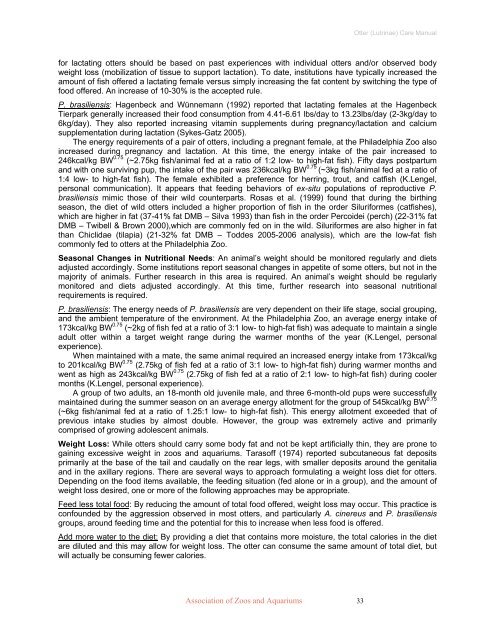Otter (Lutrinae) Care Manual - Association of Zoos and Aquariums
Otter (Lutrinae) Care Manual - Association of Zoos and Aquariums
Otter (Lutrinae) Care Manual - Association of Zoos and Aquariums
You also want an ePaper? Increase the reach of your titles
YUMPU automatically turns print PDFs into web optimized ePapers that Google loves.
<strong>Association</strong> <strong>of</strong> <strong>Zoos</strong> <strong>and</strong> <strong>Aquariums</strong> 33<br />
<strong>Otter</strong> (<strong>Lutrinae</strong>) <strong>Care</strong> <strong>Manual</strong><br />
for lactating otters should be based on past experiences with individual otters <strong>and</strong>/or observed body<br />
weight loss (mobilization <strong>of</strong> tissue to support lactation). To date, institutions have typically increased the<br />
amount <strong>of</strong> fish <strong>of</strong>fered a lactating female versus simply increasing the fat content by switching the type <strong>of</strong><br />
food <strong>of</strong>fered. An increase <strong>of</strong> 10-30% is the accepted rule.<br />
P. brasiliensis: Hagenbeck <strong>and</strong> Wünnemann (1992) reported that lactating females at the Hagenbeck<br />
Tierpark generally increased their food consumption from 4.41-6.61 lbs/day to 13.23lbs/day (2-3kg/day to<br />
6kg/day). They also reported increasing vitamin supplements during pregnancy/lactation <strong>and</strong> calcium<br />
supplementation during lactation (Sykes-Gatz 2005).<br />
The energy requirements <strong>of</strong> a pair <strong>of</strong> otters, including a pregnant female, at the Philadelphia Zoo also<br />
increased during pregnancy <strong>and</strong> lactation. At this time, the energy intake <strong>of</strong> the pair increased to<br />
246kcal/kg BW 0.75 (~2.75kg fish/animal fed at a ratio <strong>of</strong> 1:2 low- to high-fat fish). Fifty days postpartum<br />
<strong>and</strong> with one surviving pup, the intake <strong>of</strong> the pair was 236kcal/kg BW 0.75 (~3kg fish/animal fed at a ratio <strong>of</strong><br />
1:4 low- to high-fat fish). The female exhibited a preference for herring, trout, <strong>and</strong> catfish (K.Lengel,<br />
personal communication). It appears that feeding behaviors <strong>of</strong> ex-situ populations <strong>of</strong> reproductive P.<br />
brasiliensis mimic those <strong>of</strong> their wild counterparts. Rosas et al. (1999) found that during the birthing<br />
season, the diet <strong>of</strong> wild otters included a higher proportion <strong>of</strong> fish in the order Siluriformes (catfishes),<br />
which are higher in fat (37-41% fat DMB – Silva 1993) than fish in the order Percoidei (perch) (22-31% fat<br />
DMB – Twibell & Brown 2000),which are commonly fed on in the wild. Siluriformes are also higher in fat<br />
than Chiclidae (tilapia) (21-32% fat DMB – Toddes 2005-2006 analysis), which are the low-fat fish<br />
commonly fed to otters at the Philadelphia Zoo.<br />
Seasonal Changes in Nutritional Needs: An animal’s weight should be monitored regularly <strong>and</strong> diets<br />
adjusted accordingly. Some institutions report seasonal changes in appetite <strong>of</strong> some otters, but not in the<br />
majority <strong>of</strong> animals. Further research in this area is required. An animal’s weight should be regularly<br />
monitored <strong>and</strong> diets adjusted accordingly. At this time, further research into seasonal nutritional<br />
requirements is required.<br />
P. brasiliensis: The energy needs <strong>of</strong> P. brasiliensis are very dependent on their life stage, social grouping,<br />
<strong>and</strong> the ambient temperature <strong>of</strong> the environment. At the Philadelphia Zoo, an average energy intake <strong>of</strong><br />
173kcal/kg BW 0.75 (~2kg <strong>of</strong> fish fed at a ratio <strong>of</strong> 3:1 low- to high-fat fish) was adequate to maintain a single<br />
adult otter within a target weight range during the warmer months <strong>of</strong> the year (K.Lengel, personal<br />
experience).<br />
When maintained with a mate, the same animal required an increased energy intake from 173kcal/kg<br />
to 201kcal/kg BW 0.75 (2.75kg <strong>of</strong> fish fed at a ratio <strong>of</strong> 3:1 low- to high-fat fish) during warmer months <strong>and</strong><br />
went as high as 243kcal/kg BW 0.75 (2.75kg <strong>of</strong> fish fed at a ratio <strong>of</strong> 2:1 low- to high-fat fish) during cooler<br />
months (K.Lengel, personal experience).<br />
A group <strong>of</strong> two adults, an 18-month old juvenile male, <strong>and</strong> three 6-month-old pups were successfully<br />
maintained during the summer season on an average energy allotment for the group <strong>of</strong> 545kcal/kg BW 0.75<br />
(~6kg fish/animal fed at a ratio <strong>of</strong> 1.25:1 low- to high-fat fish). This energy allotment exceeded that <strong>of</strong><br />
previous intake studies by almost double. However, the group was extremely active <strong>and</strong> primarily<br />
comprised <strong>of</strong> growing adolescent animals.<br />
Weight Loss: While otters should carry some body fat <strong>and</strong> not be kept artificially thin, they are prone to<br />
gaining excessive weight in zoos <strong>and</strong> aquariums. Taras<strong>of</strong>f (1974) reported subcutaneous fat deposits<br />
primarily at the base <strong>of</strong> the tail <strong>and</strong> caudally on the rear legs, with smaller deposits around the genitalia<br />
<strong>and</strong> in the axillary regions. There are several ways to approach formulating a weight loss diet for otters.<br />
Depending on the food items available, the feeding situation (fed alone or in a group), <strong>and</strong> the amount <strong>of</strong><br />
weight loss desired, one or more <strong>of</strong> the following approaches may be appropriate.<br />
Feed less total food: By reducing the amount <strong>of</strong> total food <strong>of</strong>fered, weight loss may occur. This practice is<br />
confounded by the aggression observed in most otters, <strong>and</strong> particularly A. cinereus <strong>and</strong> P. brasiliensis<br />
groups, around feeding time <strong>and</strong> the potential for this to increase when less food is <strong>of</strong>fered.<br />
Add more water to the diet: By providing a diet that contains more moisture, the total calories in the diet<br />
are diluted <strong>and</strong> this may allow for weight loss. The otter can consume the same amount <strong>of</strong> total diet, but<br />
will actually be consuming fewer calories.









